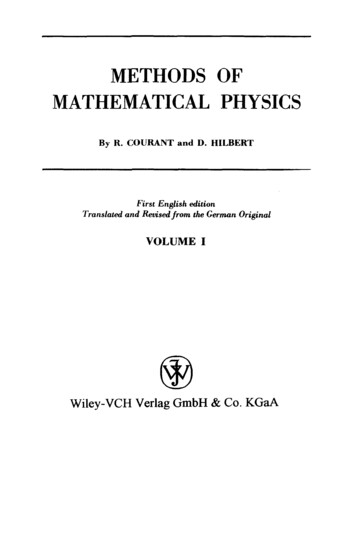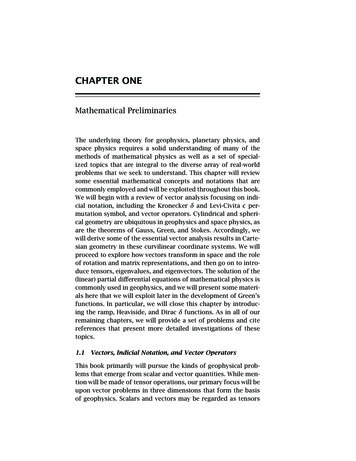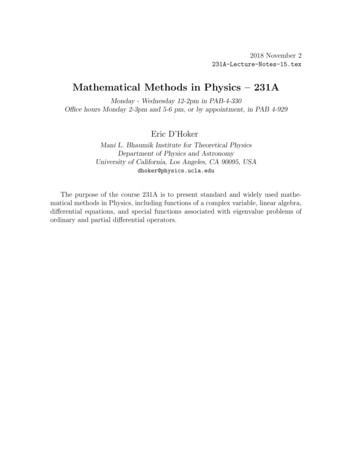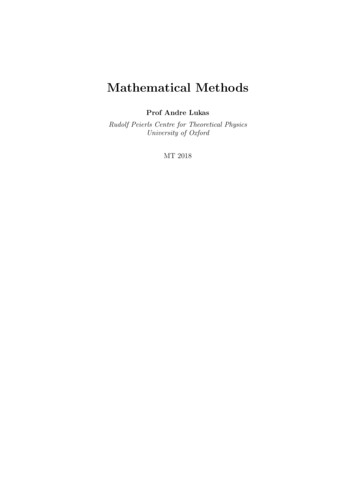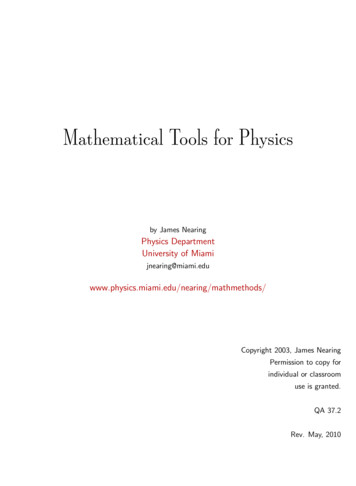
Transcription
Mathematical Tools for Physicsby James NearingPhysics DepartmentUniversity of ng/mathmethods/Copyright 2003, James NearingPermission to copy forindividual or classroomuse is granted.QA 37.2Rev. May, 2010
ContentsIntroductionBibliography1 Basic Stuff5 Fourier Seriesiiiv1TrigonometryParametric DifferentiationGaussian Integralserf and GammaDifferentiatingIntegralsPolar CoordinatesSketching Graphs2 Infinite Series6 Vector Spaces247 Operators and Matrices143The Idea of an OperatorDefinition of an OperatorExamples of OperatorsMatrix MultiplicationInversesRotations, 3-dAreas, Volumes, DeterminantsMatrices as OperatorsEigenvalues and EigenvectorsChange of BasisSummation ConventionCan you Diagonalize a Matrix?Eigenvalues and GoogleSpecial Operators52Complex NumbersSome FunctionsApplications of Euler’s FormulaGeometrySeries of cosinesLogarithmsMapping4 Differential Equations123The Underlying IdeaAxiomsExamples of Vector SpacesLinear IndependenceNormsScalar ProductBases and Scalar ProductsGram-Schmidt OrthogonalizationCauchy-Schwartz inequalityInfinite DimensionsThe BasicsDeriving Taylor SeriesConvergenceSeries of SeriesPower series, two variablesStirling’s ApproximationUseful TricksDiffractionChecking Results3 Complex Algebra100ExamplesComputing Fourier SeriesChoice of BasisMusical NotesPeriodically Forced ODE’sReturn to ParsevalGibbs Phenomenon67Linear Constant-CoefficientForced OscillationsSeries SolutionsSome General MethodsTrigonometry via ODE’sGreen’s FunctionsSeparation of VariablesCircuitsSimultaneous EquationsSimultaneous ODE’sLegendre’s EquationAsymptotic Behavior8 Multivariable Calculus179Partial DerivativesChain RuleDifferentialsGeometric InterpretationGradientElectrostaticsPlane Polar CoordinatesCylindrical, Spherical CoordinatesVectors: Cylindrical, Spherical Basesi
13 Vector Calculus 2Gradient in other CoordinatesMaxima, Minima, SaddlesLagrange MultipliersSolid AngleRainbow9 Vector Calculus 1213Fluid FlowVector DerivativesComputing the divergenceIntegral Representation of CurlThe GradientShorter Cut for div and curlIdentities for Vector OperatorsApplications to GravityGravitational PotentialIndex NotationMore Complicated Potentials10 Partial Differential Equations14 Complex Variables15 Fourier Analysis242370Fourier TransformConvolution TheoremTime-Series AnalysisDerivativesGreen’s FunctionsSine and Cosine TransformsWiener-Khinchine Theorem16 Calculus of Variations383ExamplesFunctional DerivativesBrachistochroneFermat’s PrincipleElectric FieldsDiscrete VersionClassical MechanicsEndpoint VariationKinksSecond Order267InterpolationSolving equationsDifferentiationIntegrationDifferential EquationsFitting of DataEuclidean FitDifferentiating noisy dataPartial Differential Equations12 Tensors347DifferentiationIntegrationPower (Laurent) SeriesCore PropertiesBranch PointsCauchy’s Residue TheoremBranch PointsOther IntegralsOther ResultsThe Heat EquationSeparation of VariablesOscillating TemperaturesSpatial Temperature DistributionsSpecified Heat FlowElectrostaticsCylindrical Coordinates11 Numerical Analysis325IntegralsLine IntegralsGauss’s TheoremStokes’ TheoremReynolds Transport TheoremFields as Vector Spaces17 Densities and nDelta-function NotationAlternate ApproachDifferential EquationsUsing Fourier TransformsMore DimensionsExamplesComponentsRelations between TensorsBirefringenceNon-Orthogonal BasesManifolds and FieldsCoordinate BasesBasis ChangeIndexii429
Introduction.I wrote this text for a one semester course at the sophomore-junior level. Our experience withstudents taking our junior physics courses is that even if they’ve had the mathematical prerequisites,they usually need more experience using the mathematics to handle it efficiently and to possess usableintuition about the processes involved. If you’ve seen infinite series in a calculus course, you may haveno idea that they’re good for anything. If you’ve taken a differential equations course, which of thescores of techniques that you’ve seen are really used a lot?The world is (at least) three dimensional so you clearly need to understand multiple integrals,but will everything be rectangular?How do you learn intuition?When you’ve finished a problem and your answer agrees with the back of the book or withyour friends or even a teacher, you’re not done. The way to get an intuitive understanding of themathematics and of the physics is to analyze your solution thoroughly. Does it make sense? Thereare almost always several parameters that enter the problem, so what happens to your solution whenyou push these parameters to their limits? In a mechanics problem, what if one mass is much largerthan another? Does your solution do the right thing? In electromagnetism, if you make a couple ofparameters equal to each other does it reduce everything to a simple, special case? When you’re doinga surface integral should the answer be positive or negative and does your answer agree?When you address these questions to every problem you ever solve, you do several things. First,you’ll find your own mistakes before someone else does. Second, you acquire an intuition about howthe equations ought to behave and how the world that they describe ought to behave. Third, It makesall your later efforts easier because you will then have some clue about why the equations work the waythey do. It reifies the algebra.Does it take extra time? Of course. It will however be some of the most valuable extra time youcan spend.Is it only the students in my classes, or is it a widespread phenomenon that no one is willing tosketch a graph? (“Pulling teeth” is the cliché that comes to mind.) Maybe you’ve never been taughtthat there are a few basic methods that work, so look at section 1.8. And keep referring to it. This isone of those basic tools that is far more important than you’ve ever been told. It is astounding howmany problems become simpler after you’ve sketched a graph. Also, until you’ve sketched some graphsof functions you really don’t know how they behave.When I taught this course I didn’t do everything that I’m presenting here. The two chapters,Numerical Analysis and Tensors, were not in my one semester course, and I didn’t cover all of the topicsalong the way. Several more chapters were added after the class was over, so this is now far beyond aone semester text. There is enough here to select from if this is a course text, but if you are readingit on your own then you can move through it as you please, though you will find that the first fivechapters are used more in the later parts than are chapters six and seven. Chapters 8, 9, and 13 form asort of package. I’ve tried to use examples that are not all repetitions of the ones in traditional physicstexts but that do provide practice in the same tools that you need in that context.The pdf file that I’ve placed online is hyperlinked, so that you can click on an equation or sectionreference to go to that point in the text. To return, there’s a Previous View button at the top orbottom of the reader or a keyboard shortcut to do the same thing. [Command on Mac, Alt onWindows, Control on Linux-GNU] The index pages are hyperlinked, and the contents also appear inthe bookmark window.iii
I chose this font for the display versions of the text because it appears better on the screen thandoes the more common Times font. The choice of available mathematics fonts is more limited.I’d like to thank the students who found some, but probably not all, of the mistakes in thetext. Also Howard Gordon, who used it in his course and provided me with many suggestions forimprovements. Prof. Joseph Tenn of Sonoma State University has given me many very helpful ideas,correcting mistakes, improving notation, and suggesting ways to help the students.2008A change in notation in this edition: For polar and cylindrical coordinate systems it is common to usetheta for the polar angle in one and phi for the polar angle in the other. I had tried to make them thesame (θ) to avoid confusion, but probably made it less rather than more helpful because it differed fromthe spherical azimuthal coordinate. In this edition all three systems (plane polar, cylindrical, spherical)use phi as φ tan 1 (y/x). In line integrals it is common to use ds for an element of length, andmany authors will use dS for an element of area. I have tried to avoid this confusion by sticking to d and dA respectively (with rare exceptions).In many of the chapters there are “exercises” that precede the “problems.” These are supposedto be simpler and mostly designed to establish some of the definitions that appeared in the text.This text is now available in print from Dover Publishers. They have agreed that the electronicversion will remain available online.iv
Bibliography.Mathematical Methods for Physics and Engineering by Riley, Hobson, and Bence. Cambridge University Press For the quantity of well-written material here, it is surprisingly inexpensive in paperback.Mathematical Methods in the Physical Sciences by Boas. John Wiley Publ About the right leveland with a very useful selection of topics. If you know everything in here, you’ll find all your upper levelcourses much easier.Mathematical Methods for Physicists by Arfken and Weber. Academic Presslevel, but it is sufficiently thorough that will be a valuable reference work later.At a more advancedMathematical Methods in Physics by Mathews and Walker. More sophisticated in its approach tothe subject, but it has some beautiful insights. It’s considered a standard, though now hard to obtain.Mathematical Methods by Hassani. Springer At the same level as this text with many of the sametopics, but said differently. It is always useful to get a second viewpoint because it’s commonly thesecond one that makes sense — in whichever order you read them.Schaum’s Outlines by various.There are many good and inexpensive books in this series: forexample, “Complex Variables,” “Advanced Calculus,” “German Grammar.” Amazon lists hundreds.Visual Complex Analysis by Needham, Oxford University Press The title tells you the emphasis.Here the geometry is paramount, but the traditional material is present too. It’s actually fun to read.(Well, I think so anyway.) The Schaum text provides a complementary image of the subject.Complex Analysis for Mathematics and Engineering by Mathews and Howell. Jones and BartlettPress Another very good choice for a text on complex variables. Despite the title, mathematiciansshould find nothing wanting here.Applied Analysis by Lanczos. Dover Publications This publisher has a large selection of moderatelypriced, high quality books. More discursive than most books on numerical analysis, and shows greatinsight into the subject.Linear Differential Operators by Lanczos. Dover publicationsinsights and unusual ways to look at the subject.As always with this author, usefulNumerical Methods that (usually) Work by Acton. Mathematical Association of Americatools with more than the usual discussion of what can (and will) go wrong.PracticalNumerical Recipes by Press et al. Cambridge Press The standard current compendium surveyingtechniques and theory, with programs in one or another language.A Brief on Tensor Analysis by James Simmonds. Springerwill recommend. To anyone. Under any circumstances.Linear Algebra Done Right by Axler. SpringerLinear Algebra Done Wrong by Treil.its own sake.This is the only text on tensors that IDon’t let the title turn you away. It’s pretty good.(online at Brown University) Linear Algebra not just forAdvanced mathematical methods for scientists and engineers by Bender and Orszag. SpringerMaterial you won’t find anywhere else, with clear examples. “. . . a sleazy approximation that providesv
good physical insight into what’s going on in some system is far more useful than an unintelligible exactresult.”Probability Theory: A Concise Course by Rozanov. Doverway in 148 pages. Clear and explicit and cheap.Starts at the beginning and goes a longCalculus of Variations by MacCluer. Pearson Both clear and rigorous, showing how many differenttypes of problems come under this rubric, even “. . . operations research, a field begun by mathematicians, almost immediately abandoned to other disciplines once the field was determined to be usefuland profitable.”Special Functions and Their Applications by Lebedev. Doverfunctions developed in order to be useful, not just for sport.The most important of the specialThe Penguin Dictionary of Curious and Interesting Geometry by Wells. Penguin Just for fun. Ifyour heart beats faster at the sight of the Pythagorean Theorem, wait ’til you’ve seen Morley’s Theorem,or Napoleon’s, or when you first encounter an unduloid in its native habitat.vi
Basic Stuff.1.1 TrigonometryThe common trigonometric functions are familiar to you, but do you know some of the tricks toremember (or to derive quickly) the common identities among them? Given the sine of an angle, whatis its tangent? Given its tangent, what is its cosine? All of these simple but occasionally useful relationscan be derived in about two seconds if you understand the idea behind one picture. Suppose for examplethat you know the tangent of θ, what is sin θ? Draw a right triangle and designate the tangent of θ asx, so you can draw a triangle with tan θ x/1. The Pythagorean theorem says that the third side is 1 x2 . You nowread the sine from the triangle as x/ 1 x2 , soxθtan θsin θ 1 tan2 θ1Any other such relation is done the same way. You know the cosine, so what’s the cotangent? Draw adifferent triangle where the cosine is x/1.RadiansWhen you take the sine or cosine of an angle, what units do you use? Degrees? Radians? Cycles? Andwho invented radians? Why is this the unit you see so often in calculus texts? That there are 360 ina circle is something that you can blame on the Sumerians, but where did this other unit come from?2θsRθ2RIt results from one figure and the relation between the radius of the circle, the angle drawn,and the length of the arc shown. If you remember the equation s Rθ, does that mean that for afull circle θ 360 so s 360R? No. For some reason this equation is valid only in radians. Thereasoning comes down to a couple of observations. You can see from the drawing that s is proportionalto θ — double θ and you double s. The same observation holds about the relation between s and R,a direct proportionality. Put these together in a single equation and you can conclude thats CR θwhere C is some constant of proportionality. Now what is C ?You know that the whole circumference of the circle is 2πR, so if θ 360 , then2πR CR 360 ,andC π180degree 1It has to have these units so that the left side, s, comes out as a length when the degree unitscancel. This is an awkward equation to work with, and it becomes very awkward when you try to docalculus. An increment of one in θ is big if you’re in radians, and small if you’re in degrees, so itshould be no surprise that sin θ/ θ is much smaller in the latter units:dπsin θ cos θdθ1801in degrees
1—Basic Stuff2This is the reason that the radian was invented. The radian is the unit designed so that the proportionality constant is one.C 1 radian 1s 1 radian 1 Rθ thenIn practice, no one ever writes it this way. It’s the custom simply to omit the C and to say thats Rθ with θ restricted to radians — it saves a lot of writing. How big is a radian? A full circle hascircumference 2πR, and this equals Rθ when you’ve taken C to be one. It says that the angle for afull circle has 2π radians. One radian is then 360/2π degrees, a bit under 60 . Why do you always useradians in calculus? Only in this unit do you get simple relations for derivatives and integrals of thetrigonometric functions.Hyperbolic FunctionsThe circular trigonometric functions, the sines, cosines, tangents, and their reciprocals are familiar, buttheir hyperbolic counterparts are probably less so. They are related to the exponential function ascosh x ex e x2,sinh x ex e x2,tanh x sinh xex e x xcosh xe e x(1.1)The other three functions aresech x 1,cosh xcsch x 1,sinh xcoth x 1tanh xDrawing these is left to problem 1.4, with a stopover in section 1.8 of this chapter.Just as with the circular functions there are a bunch of identities relating these functions. Forthe analog of cos2 θ sin2 θ 1 you havecosh2 θ sinh2 θ 1(1.2)For a proof, simply substitute the definitions of cosh and sinh in terms of exponentials and watchthe terms cancel. (See problem 4.23 for a different approach to these functions.) Similarly the othercommon trig identities have their counterpart here.1 tan2 θ sec2 θhas the analog1 tanh2 θ sech2 θ(1.3)The reason for this close parallel lies in the complex plane, because cos(ix) cosh x and sin(ix) i sinh x. See chapter three.The inverse hyperbolic functions are easier to evaluate than are the corresponding circular functions. I’ll solve for the inverse hyperbolic sine as an exampley sinh xmeansx sinh 1 y,y ex e x2,Multiply by 2ex to get the quadratic equation2ex y e2x 1orex 2 2y e x 1 0solve for x.
1—Basic Stuff3pThe solutions to this are ex y y 2 1, and because y 2 1 is always greater than y , you musttake the positive sign to get a positive ex . Take the logarithm of ex andpsinhsinh 1px sinh 1 y ln y y 2 1( y ) As x goes through the values to , the values that sinh x takes on go over the range to . This implies that the domain of sinh 1 y is y . The graph of an inverse functionis the mirror image of the original function in the 45 line y x, so if you have sketched the graphs ofthe original functions, the corresponding inverse functions are just the reflections in this diagonal line.The other inverse functions are found similarly; see problem 1.3sinh 1 y ln y py2 1 p y 1cosh 1 y ln y y 2 1 ,11 ytanh 1 y ln, y 12 1 y1 y 1coth 1 y ln, y 12 y 1(1.4)The cosh 1 function is commonly written with only the sign before the square root. What does theother sign do? Draw a graph and find out. Also, what happens if you add the two versions of thecosh 1 ?The calculus of these functions parallels that of the circular functions.dd ex e x ex e xsinh x cosh xdxdx22Similarly the derivative of cosh x is sinh x. Note the plus sign here, not minus.Where do hyperbolic functions occur? If you have a mass in equilibrium, the total force on itis zero. If it’s in stable equilibrium then if you push it a little to one side and release it, the force willpush it back to the center. If it is unstable then when it’s a bit to one side it will be pushed fartheraway from the equilibrium point. In the first case, it will oscillate about the equilibrium position and forsmall oscillations the function of time will be a circular trigonometric function — the common sines orcosines of time, A cos ωt. If the point is unstable, the motion will be described by hyperbolic functionsof time, sinh ωt instead of sin ωt. An ordinary ruler held at one end will swing back and forth, but ifyou try to balance it at the other end it will fall over. That’s the difference between cos and cosh. Fora deeper understanding of the relation between the circular and the hyperbolic functions, see section3.3
1—Basic Stuff41.2 Parametric DifferentiationThe integration techniques that appear in introductory calculus courses include a variety of methods ofvarying usefulness. There’s one however that is for some reason not commonly done in calculus courses:parametric differentiation. It’s best introduced by an example.Z xn e x dx0You could integrate by parts n times and that will work. For example, n 2:Z Z x2 e x 2xe x dx 0 2xe x 2e x dx 0 2e x0000 20Instead of this method, do something completely different. Consider the integralZ e αx dx(1.5)0It has the parameter α in it. The reason for this will be clear in a few lines. It is easy to evaluate, and isZ 1 αx 1e αx dx e αα00Now differentiate this integral with respect to α,Zd αxd 1edx ordαZAnd again and again: dα α0 The nth derivative isZ xe αx dx 0x2 e αx dx 0 Zα Z 2,3 0xn e αx dx 0 n!αn 1 1α2x3 e αx dx 2 . 3α4(1.6)Set α 1 and you see that the original integral is n!. This result is compatible with the standarddefinition for 0!. From the equation n! n .(n 1)!, you take the case n 1, and it requires 0! 1in order to make any sense. This integral gives the same answer for n 0.The idea of this method is to change the original problem into another by introducing a parameter.Then differentiate with respect to that parameter in order to recover the problem that you really wantto solve. With a little practice you’ll find this easier than partial integration. Also see problem 1.47 fora variation on this theme.Notice that I did this using definite integrals. If you try to use it for an integral without limitsyou can sometimes get into trouble. See for example problem 1.42.1.3 Gaussian IntegralsGaussian integrals are an important class of integrals that show up in kinetic theory, statistical mechanics, quantum mechanics, and any other place with a remotely statistical aspect.Z2dx xn e αxThe simplest and most common case is the definite integral from to or maybe from 0 to .
1—Basic Stuff5If n is a positive odd integer, these are elementary, Zn 12dx xn e αx 0(n odd)(1.7) To see why this is true, sketch graphs of the integrand for a few more odd n.For the integral over positive x and still for odd n, do the substitution t αx2 .Z n αx2dx x e 2α(n 1)/20 Z1dt t(n 1)/2 e t 012α(n 1)/2 (n 1)/2 !(1.8)Because n is odd, (n 1)/2 is an integer and its factorial makes sense.If n is even then doing this integral requires a special preliminary trick. Evaluate the special casen 0 and α 1. Denote the integral by I , then ZI x2dx e, Z2I and x2 Z dx e y 2 dy e In squaring the integral you must use a different label for the integration variable in the second factoror it will get confused with the variable in the first factor. Rearrange this and you have a conventionaldouble integral.ZZ I2 2 y 2 )dy e (xdx This is something that you can recognize as an integral over the entire x-y plane. Now the trick isto switch to polar coordinates*. The element of area dx dy now becomes r dr dφ, and the respectivelimits on these coordinates are 0 to and 0 to 2π . The exponent is just r2 x2 y 2 .2Z 2π ZI r dr0dφ e r20The φ integral simply gives 2π . For the r integral substitute r2 z and the result is 1/2. [Or useEq. (1.8).] The two integrals together give you π .Z2I π, so2dx e x π(1.9) Now do the rest of these integrals by parametric differentiation, introducing a parameter with22which to carry out the derivatives. Change e x to e αx , then in the resulting integral change variablesto reduce it to Eq. (1.9). You getZ αx2dx e r π,αZ 2 αx2dx x eso d dαrπ 1 α 2 πα3/2(1.10)You can now get the results for all the higher even powers of x by further differentiation with respectto α.* See section 1.7 in this chapter
1—Basic Stuff61.4 erf and GammaWhat about the same integral, but with other limits? The odd-n case is easy to do in just the sameway as when the limits are zero and infinity: just do the same substitution that led to Eq. (1.8). Theeven-n case is different because it can’t be done in terms of elementary functions. It is used to definean entirely new function.Z x22erf(x) dt e 84301.250.9231.500.9671.750.9872.000.995This is called the error function. It’s well studied and tabulated and even shows up as a buttonon some* pocket calculators, right along with the sine and cosine. (Is erf odd or even or neither?)(What is erf( )?)A related integral worthy of its own name is the Gamma function.Z Γ(x) dt tx 1 e t(1.12)0The special case in which x is a positive integer is the one that I did as an example of parametricdifferentiation to get Eq. (1.6). It isΓ(n) (n 1)!The factorial is not defined if its argument isn’t an integer, but the Gamma function is perfectlywell defined for any argument as long as the integral converges. One special case is notable: x 1/2.Z Z Z 2 1/2 t 1 u2Γ(1/2) dt te 2u du u e(1.13) 2du e u π000u2I used t and then the result for the Gaussian integral, Eq. (1.9). You can use parametricdifferentiation to derive a simple and useful recursion relation. (See problem 1.14 or 1.47.)xΓ(x) Γ(x 1)(1.14)From this you can get the value of Γ(1 1/2), Γ(2 1/2), etc. In fact, if you know the value of the functionin the interval between one and two, you can use this relationship to get it anywhere else on the axis.You already know that Γ(1) 1 Γ(2). (You do? How?) As x approaches zero, use the relationΓ(x) Γ(x 1)/x and because the numerator for small x is approximately 1, you immediately havethatΓ(x) 1/xfor small x(1.15)The integral definition, Eq. (1.12), for the Gamma function is defined only for the case thatx 0. [The behavior of the integrand near t 0 is approximately tx 1 . Integrate this from zero tosomething and see how it depends on x.] Even though the original definition of the Gamma functionfails for negative x, you can extend the definition by using Eq. (1.14) to define Γ for negative arguments.What is Γ( 1/2) for example? Put x 1/2 in Eq. (1.14). 1 Γ( 1/2) Γ( (1/2) 1) Γ(1/2) π,2so Γ( 1/2) 2 π(1.16)* See for example rpncalculator (v1.96 the latest). It is the best desktop calculator that I’ve found(Mac and Windows). This main site seems (2008) to have disappeared, but I did find other sourcesby searching the web for the pair “rpncalculator” and baker. The latter is the author’s name. I tor-x/
1—Basic Stuff7The same procedure works for other negative x, though it can take several integer steps to get to apositive value of x for which you can use the integral definition Eq. (1.12).The reason for introducing these two functions now is not that they are so much more importantthan a hundred other functions that I could use, though they are among the more common ones.The point is that the world doesn’t end with polynomials, sines, cosines, and exponentials. There arean infinite number of other functions out there waiting for you and some of them are useful. Thesefunctions can’t be expressed in terms of the elementary functions that you’ve grown to know and love.They’re different and have their distinctive behaviors.551 2erf 12 4Γ4 41/Γ4 5 5There are zeta functions and Fresnel integrals and Legendre functions and Exponential integralsand Mathieu functions and Confluent Hypergeometric functions and . . . you get the idea. When one ofthese shows up, you learn to look up its properties and to use them. If you’re interested you may even tryto understand how some of these properties are derived, but probably not the first time that you confrontthem. That’s why there are tables, and the “Handbook of Mathematical Functions” by Abramowitzand Stegun is a premier example of such a tabulation, and it’s reprinted by Dover Publications. There’salso a copy on the internet* www.math.sfu.ca/ cbm/aands/ as a set of scanned page images.Why erf?What can you do with this function? The most likely application is probably to probability. If you flipa coin 1000 times, you expect it to come up heads about 500 times. But just how close to 500 willit be? If you flip it twice, you wouldn’t be surprised to see two heads or two tails, in fact the equallylikely possibilities areTTHTTHHHThis says that in 1 out of 4 such experiments you expect to see two heads and in 1 out of 4 youexpect two tails. For just 2 out of 4 times you do the double flip do you expect exactly one head. Allthis is an average. You have to try the experiment many times to see your expectation verified, and thenonly by averaging many experiments.It’s easier to visualize the counting if you flip N coins at once and see how they come up. Thenumber of coins that come up heads won’t always be N/2, but it should be close. If you repeat theprocess, flipping N coins again and again, you get a distribution of numbers of heads that will varyaround N/2 in a characteristic pattern. The result is that the fraction of the time it will come up withk heads and N k tails is, to a good approximationr2 2δ 2 /NNe,whereδ k (1.17)πN222The derivation of this can wait until section 2.6, Eq. (2.26). It is an accurate result if the number ofcoins that you flip in each trial is large, but try it anyway for the preceding example where N 2. Thisformula says that the fraction of times predicted for k heads isqk 0 : 1/π e 1 0.208k 1 N/2 : 0.564k 2 : 0.208* now superceded by the online work dlmf.nist.gov/ at the National Institute of Standards andTechnology
1—Basic Stuff8The exact answers are 1/4, 2/4, 1/4, but as two is not all that big a number, the fairly large errorshouldn’t be distressing.If you flip three coins, the equally likely possibilities areTTT TTH THT HTT THH HTH HHT HHHThere are 8 possibilities here, 23 , so you expect (on average) one run out of 8 to give you 3 heads.Probability 1/8.To see how accurate this claim is for modest values, take N 10. The possible outcomes areanywhere from zero heads to ten. The exact fraction of the time that you get k heads as compared tothis approximation isk exact:approximate:012345.000977 .00977 .0439 .117 .205 .246.0017.0103 .0417 .113 .206 .2522For the more interesting case of big N , the exponent, e 2δ /N , varies slowly and smoothly asδ changes in integer steps away from zero. This is a key point; it allows you to approximate a sumby an integral. If N 1000 and δ 10, the exponent is 0.819. It has dropped only gradually fromone. For the samepN 1000, the fraction of the time to get exactly 500 heads is 0.025225, and thisapproximati
The pdf le that I’ve placed online is hyperlinked, so that you can click on an equation or section reference to go to that point in the text. To return, there’s a Previous View button at the top or . Mathematical Methods in the Physical Sciences by Boas. John Wiley Publ About the right


